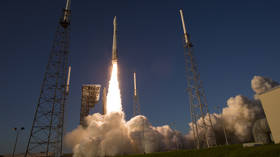NASA finds water and carbon on asteroid
Samples obtained by the OSIRIS-REx probe may provide insight into how life arose on Earth
Samples taken from the asteroid Bennu by NASA’s OSIRIS-REx probe are rich in water and carbon-containing compounds, the US space agency revealed in a live webcast on Wednesday.
The mission completed the 1.4 billion mile (2.3 billion km) return journey from the asteroid last month, depositing in the Utah desert a collection capsule laden with about 8.8 ounces (250g) of material collected from Bennu in late 2020.
The samples were taken to NASA’s Johnson Space Center in Houston, which will parcel them out to researchers around the world for closer study. Scientists hope the material will provide some insight into the origins of life on Earth, as many believe carbon-rich asteroids hitting the planet deposited the necessary elements for organic life to arise.
NASA’s principal investigator on the mission, University of Arizona planetary scientist Dante Lauretta, described the asteroid as “a time capsule that offers us profound insights into the origins of our solar system.”
The bounty of carbon-rich material and the abundant presence of water-bearing clay minerals are just the tip of the cosmic iceberg.
Bennu had already surprised scientists even before they got to study it up close. When the OSIRIS-REx probe initially attempted to approach the surface to extract a sample, after spending 22 months orbiting the asteroid to find the perfect spot, the exterior turned out to be extremely porous, rather than the rigid rock NASA was expecting. Rather than encountering resistance, the spacecraft began sinking into the surface, an experience Lauretta described as “frightening.”
The probe only narrowly escaped being engulfed by Bennu by firing its thrusters, and the crater left behind was massive – 26 feet (8m) instead of the tiny indentation scientists had expected. They concluded that the particles comprising Bennu’s exterior were “so loosely packed and lightly bound to each other that they act more like a fluid than a solid” – an attribute that would have major implications for any deflection efforts should an asteroid of Bennu’s type end up on a collision course with Earth.
After depositing its capsule back on Earth, the OSIRIS-REx probe began the long voyage to the asteroid Apophis, where it is due to arrive in 2029. While no samples will be taken, the probe will spend 18 months imaging and mapping the asteroid. Apophis was once thought to be at risk of impacting the Earth in 2068, but that threat is no longer considered credible. Scientists hope to learn something about other asteroids of the same type that may end up on a collision course with our planet.






Comments are closed.